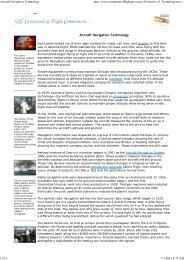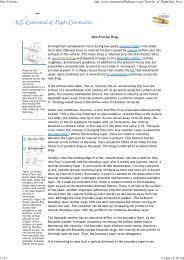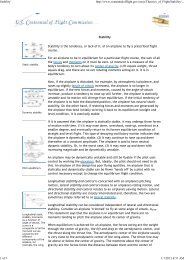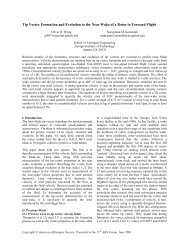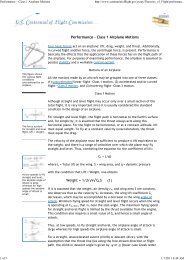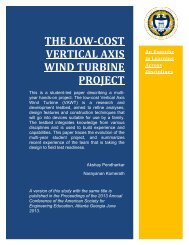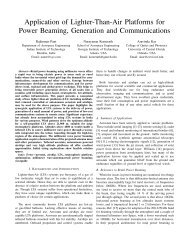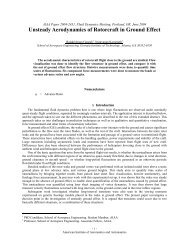Boeing-University Relations - A Review and Prospects for the Future
Boeing-University Relations - A Review and Prospects for the Future
Boeing-University Relations - A Review and Prospects for the Future
Create successful ePaper yourself
Turn your PDF publications into a flip-book with our unique Google optimized e-Paper software.
<strong>Boeing</strong>-<strong>University</strong> <strong>Relations</strong> - A <strong>Review</strong> <strong>and</strong> <strong>Prospects</strong> <strong>for</strong> <strong>the</strong> <strong>Future</strong>John H. McMasters, Narayanan KomerathThe <strong>Boeing</strong> Company / Georgia Institute of TechnologyAbstractThe <strong>Boeing</strong> Company has been noteworthy within <strong>the</strong> aerospace industry <strong>for</strong> its ambitiousuniversity relations program originally conceived in <strong>the</strong> early 1990s. This program has aimed atnot only creating strong company relations with universities important to its business interests,but also to lead broader industry ef<strong>for</strong>ts to enhance engineering <strong>and</strong> related technical <strong>and</strong>business education programs across <strong>the</strong> nation. This paper reviews <strong>the</strong> development of <strong>the</strong><strong>Boeing</strong> program, discusses important lessons learned from <strong>the</strong> overall ef<strong>for</strong>t, <strong>and</strong> outlinesprospects <strong>for</strong> future developments. Specific program elements are discussed. Key in this hasbeen <strong>the</strong> Welliver Faculty Summer Fellowship Program which, after a decade of operation, canbe considered to have met its initial expectations. Reasons <strong>for</strong> successes <strong>and</strong> failures will bediscussed <strong>and</strong> opportunities <strong>for</strong> future developments will be identified. Alumni of this programhave enhanced <strong>the</strong> relevance of engineering education by incorporating industry perspectives,<strong>and</strong> industry has benefited from <strong>the</strong> perspectives <strong>and</strong> insights brought by <strong>the</strong> faculty participants.The paper will survey <strong>the</strong> results from <strong>the</strong> program <strong>and</strong> relate <strong>the</strong>m to <strong>the</strong> needs of <strong>the</strong> present<strong>and</strong> future aerospace industry <strong>and</strong> engineering academe.IntroductionConsolidation, new technologies <strong>and</strong> globalization have continued to bring new priorities <strong>and</strong>rapid change to <strong>the</strong> aerospace industry. Through <strong>the</strong>se interesting times, <strong>the</strong> work<strong>for</strong>ce <strong>and</strong>infrastructure have been aging at an alarming rate. Traditional means of experience-building withneeded knowledge retention <strong>and</strong> transfer have been severely strained, as traditional processes<strong>and</strong> time-scales <strong>for</strong> developing products <strong>and</strong> <strong>the</strong> associated skills have evolved. Partiallyanticipating <strong>the</strong>se changes in industry, <strong>Boeing</strong> took <strong>the</strong> lead in highlighting <strong>the</strong> need <strong>for</strong> changein <strong>the</strong>ir supply chain of talent – <strong>the</strong> university system. This need was articulated <strong>and</strong> pursuedthrough its ambitious university relations program, originally conceived in <strong>the</strong> early 1990s. Thisprogram has aimed to create strong company relations with universities important to its businessinterests. It has also led broader industry ef<strong>for</strong>ts to enhance engineering <strong>and</strong> related technical <strong>and</strong>business education programs across <strong>the</strong> nation. As new challenges continue to loom, this paperreviews <strong>the</strong> development of <strong>the</strong> <strong>Boeing</strong> program, discusses important lessons learned from <strong>the</strong>overall ef<strong>for</strong>t, <strong>and</strong> outlines prospects <strong>for</strong> future developments. The authors’ experience is used todevelop both an industry <strong>and</strong> a university perspective, not to be attributed exclusively to one or<strong>the</strong> o<strong>the</strong>r. In some important particulars, <strong>the</strong> authors agree; on o<strong>the</strong>r topics <strong>the</strong>y may not. In sum,<strong>the</strong>se convergences or divergences of opinion may be considered reasonably representative of <strong>the</strong>Proceedings of <strong>the</strong> 2005 American Society <strong>for</strong> Engineering Education Annual Conference & ExpositionCopyright ASEE 2005, American Society <strong>for</strong> Engineering Education.
current state of affairs in relations between academe <strong>and</strong> industry in general, <strong>and</strong> ourobservations <strong>and</strong> opinions are offered in this context. Despite any differences in opinion, <strong>the</strong>authors remain friends <strong>and</strong> share a mutual passion <strong>for</strong> enhancing engineering education.Industry PerspectiveConcerns about <strong>the</strong> future of engineering education were identified by many in <strong>the</strong> late 1980’s<strong>and</strong> early 1990’s. Many of <strong>the</strong> more pointed concerns expressed at that time related toundergraduate ra<strong>the</strong>r than graduate-level engineering education. These concerns are to somedegree still active <strong>and</strong> include:• Our future supply of engineering talent is threatened. Current engineering educationprograms are failing to attract <strong>and</strong> retain an adequate number of students, especially women<strong>and</strong> minorities. Undergraduate programs still resemble “preparation <strong>for</strong> a Ph.D. program”ra<strong>the</strong>r than “preparation <strong>for</strong> professional practice”. Large majorities of existing facultymembers have little or no significant industry experience, <strong>and</strong> thus have little underst<strong>and</strong>ingof rapidly evolving employer needs.• Engineering education costs a lot <strong>for</strong> what we get. Costs are rising alarmingly, whileundergraduates are not getting full value <strong>for</strong> <strong>the</strong>ir money. Too many are turned off by whatis offered. Employers continue to pay <strong>the</strong> full (often hidden) bill <strong>for</strong> teaching graduateswhat <strong>the</strong>y need to know, but are not taught in school. There is a potential major savings <strong>for</strong>industry in investing early in <strong>the</strong> educational process, ra<strong>the</strong>r than paying <strong>the</strong> bill later.• Major opportunities <strong>for</strong> re<strong>for</strong>m exist but remain to be exploited. Significant advances havebeen made in our knowledge of how people learn <strong>and</strong> develop, while new teaching methods<strong>and</strong> curricular organization have been demonstrated 1, 2 , but have not been widely accepted.Too little has changed in undergraduate engineering education delivery in <strong>the</strong> past 50 years.Much thought has been devoted in both industry <strong>and</strong> academe to <strong>the</strong> future of our enterprise <strong>and</strong><strong>the</strong> technical work<strong>for</strong>ce needed to support it 3 . However, predicting an unknowable, but likelycontinually volatile future presents many problems. In such situations it is sometimes valuable toexamine current events <strong>and</strong> concerns in terms of much longer historical time scales. In this wayone may attempt to discern basic trends <strong>and</strong> durable characteristics that might provide usefulguidance <strong>for</strong> our future, <strong>and</strong> avoid <strong>the</strong> dangers of extrapolating from a possible bubble or troughin any evolutionary process. With this longer-term perspective in h<strong>and</strong>, one <strong>the</strong>n may examinewhat new developments might occur which could produce changes in <strong>the</strong> ‘old way of doingbusiness’. The futurist’s role is thus to examine “what could happen (if wanted <strong>and</strong> nounknowable events intervene)” ra<strong>the</strong>r than attempt to predict <strong>the</strong> future.One successful example of this approach was its use in <strong>the</strong> construction circa 1993-94 of <strong>the</strong><strong>Boeing</strong> list 4,5 of “Desired Attributes of an Engineer” (Fig. 1). The original purpose in creatingthis list was to establish a basis <strong>for</strong> an on-going dialogue with academe at a time when muchlegitimate criticism was leveled at various potential employers <strong>for</strong> a seeming propensity <strong>for</strong>“changing <strong>the</strong>ir minds all <strong>the</strong> time” <strong>and</strong> sending often contradictory messages to schoolsregarding “what industry needs”. Ra<strong>the</strong>r than provide schools with continually changing lists ofProceedings of <strong>the</strong> 2005 American Society <strong>for</strong> Engineering Education Annual Conference & ExpositionCopyright ASEE 2005, American Society <strong>for</strong> Engineering Education.
“near-term expected jobs”, what seemed needed was an enumeration of <strong>the</strong> durable foundationalskills <strong>and</strong> knowledge that all engineers have always needed to posses, based on experience inprofessional practice over <strong>the</strong> long-term (i.e. centuries). To be useful, such a listing shouldcontain no “flavors of <strong>the</strong> month” - no matter how apparently worthy at any given time. Thehope was that our list could thus be used as a basis <strong>for</strong> discussing systemic changes inengineering education programs required to better align <strong>the</strong>m with truly strategic employerneeds, i.e. teaching <strong>the</strong>se fundamentals should st<strong>and</strong> any student in good stead, no matter how<strong>the</strong> world might change in <strong>the</strong> future.<strong>Boeing</strong> List of “Desired Attributes of an Engineer”• A good underst<strong>and</strong>ing ofengineering sciencefundamentals– Ma<strong>the</strong>matics (including statistics)– Physical <strong>and</strong> life sciences– In<strong>for</strong>mation technology (far more than“computer literacy”)• A good underst<strong>and</strong>ing of design<strong>and</strong> manufacturing processes (i.e.underst<strong>and</strong>s engineering)• A multi-disciplinary, systemsperspective• A basic underst<strong>and</strong>ing of <strong>the</strong>context in which engineering ispracticed– Economics (including businesspractice)– History– The environment– Customer <strong>and</strong> societal needs• Good communication skills– Written– Oral– Graphic– Listening• High ethical st<strong>and</strong>ards• An ability to think both critically<strong>and</strong> creatively - independently<strong>and</strong> cooperatively• Flexibility. The ability <strong>and</strong> selfconfidenceto adapt to rapid ormajor change• Curiosity <strong>and</strong> a desire to learn <strong>for</strong>life• A profound underst<strong>and</strong>ing of <strong>the</strong>importance of teamwork.Diversity – wanted <strong>and</strong> needed !http://www.boeing.com/companyoffices/pwu/attributes/attributes.htmlFigure 1: Desired Attributes of an Engineer.The list that was constructed in this way has served us well <strong>for</strong> <strong>the</strong> past decade <strong>and</strong> was one ofthree basic source documents used in framing <strong>the</strong> “Student Learning Outcomes” section inABET Engineering Criteria 2000 approved in 1996. New ABET EC 2000 accreditation rulesencourage ra<strong>the</strong>r than hinder educational experimentation 2 , although many schools have yet tofully realize <strong>and</strong> exploit <strong>the</strong>se opportunities. In general, it has not been found necessary tochange anything on <strong>the</strong> list over <strong>the</strong> decade since it was first published, <strong>and</strong> much constructivedialogue has been generated by it. It thus remains our basic message to academe regarding whatindustry needs of <strong>the</strong>ir graduates. If one were to modify it today, <strong>the</strong> one item that is probablynecessary to add is: “Possess a global awareness”. Knowledge of a <strong>for</strong>eign language is one goodbeginning point in creating a needed multi-cultural perspective among future graduates.Proceedings of <strong>the</strong> 2005 American Society <strong>for</strong> Engineering Education Annual Conference & ExpositionCopyright ASEE 2005, American Society <strong>for</strong> Engineering Education.
Enhancing Engineering Education – From Conception to LegacyFor many years, undergraduate engineering education has been based on <strong>the</strong> implicit assumptionthat we must attempt to teach students “everything <strong>the</strong>y might need to know” be<strong>for</strong>e <strong>the</strong>y enterprofessional practice – while trying hard not to lose too many of <strong>the</strong>m in <strong>the</strong> process 3 . As newtechnological areas became important in an engineering discipline, new courses would be addedto cover <strong>the</strong>m. While this has caused constant rethinking of what constituted “essentialfundamentals”, it has also resulted in curriculum compression – sometimes to extreme levels.Faced with pressure to add material, reduce time, <strong>and</strong> satisfy <strong>the</strong> dem<strong>and</strong>s of <strong>the</strong> (sometimesarchaic) industry hiring practices, academe too often resorted to a balkanization approach incurriculum development.One possible solution to our overall dilemma is to make <strong>the</strong> entry level requirement <strong>for</strong>professional practice a 5- or 6-year program. This is at best only a partial solution to <strong>the</strong>problem. While science <strong>and</strong> ma<strong>the</strong>matics provide <strong>the</strong> engineer much of <strong>the</strong> basic tool <strong>and</strong>knowledge suite needed <strong>for</strong> practice, it is design, <strong>and</strong> more recently its abstraction into systemsengineering, that is <strong>the</strong> essence of our profession. In educating engineers <strong>for</strong> our future, we needto think in terms of a truly student-centered approach with quality ra<strong>the</strong>r than quantity being anobjective at <strong>the</strong> undergraduate level, with much of <strong>the</strong> specialization in current programsdeferred to <strong>the</strong> graduate level <strong>and</strong> continued career-long learning opportunities.At <strong>the</strong> undergraduate level, we need to adopt a modern systems engineering perspective <strong>and</strong> do amuch better job of determining what really needs to be presented (<strong>and</strong> how to present it) in ouref<strong>for</strong>ts to educate students to operate in a modern engineering environment, ra<strong>the</strong>r than merelythinking about what specific skills <strong>the</strong>y may need in order to gain <strong>the</strong>ir initial job assignments, oras preparation <strong>for</strong> a graduate program in research. Instead of creating courses to meet specific(<strong>and</strong> too often parochial) needs, we must develop in our students a basic underst<strong>and</strong>ing of <strong>the</strong>unity of <strong>the</strong> fundamental tools <strong>and</strong> concepts needed <strong>for</strong> engineering practice ra<strong>the</strong>r thanproviding <strong>the</strong>m a vast bag of tricks <strong>for</strong> solving selected problems.Perhaps most difficult of all is to create a culture <strong>and</strong> climate where faculty are willing <strong>and</strong> ableto function as a team. In doing so, <strong>the</strong>y serve as powerful role models <strong>for</strong> <strong>the</strong>ir students - as agroup of engineers who are true exemplars of life-long learning <strong>and</strong> team-based problem solving.<strong>Boeing</strong>’s Ef<strong>for</strong>ts to Be ProactiveHaving identified <strong>and</strong> spotlighted <strong>the</strong> issues, circa 1993-94 <strong>Boeing</strong> began ef<strong>for</strong>ts to help make adifference. The structure of what became <strong>the</strong> suite of “Education Outreach” programs <strong>and</strong> <strong>the</strong>roles of <strong>the</strong> different components are shown in Fig. 2. Developed under <strong>the</strong> auspices of what isnow <strong>the</strong> company offices-level <strong>University</strong> <strong>Relations</strong> Process Council in conjunction with a selectgroup of faculty representing a cross section of universities significant to company interests, thissuite of programs <strong>and</strong> initiatives included:• An annual series of <strong>Boeing</strong>-<strong>University</strong> Workshops held from 1994-1998, whichbrought toge<strong>the</strong>r Deans <strong>and</strong> Department Chairs from approximately sixty colleges <strong>and</strong>universities across <strong>the</strong> country to discuss relations between <strong>the</strong>ir institutions <strong>and</strong> <strong>the</strong>company, share mutual concerns, <strong>and</strong> develop ways to resolve <strong>the</strong>m in cooperative ways.Proceedings of <strong>the</strong> 2005 American Society <strong>for</strong> Engineering Education Annual Conference & ExpositionCopyright ASEE 2005, American Society <strong>for</strong> Engineering Education.
[Note: The <strong>Boeing</strong> list of <strong>the</strong> “Desired Attributes” (Fig. 1) was developed specifically toaid this type of discussion.]• The <strong>Boeing</strong> Outst<strong>and</strong>ing Educator Award Program [Note: This program began in1995 <strong>and</strong> ended in 2001 with <strong>the</strong> advent of <strong>the</strong> similar but more generous Gordon Prizeoffered under <strong>the</strong> auspices of <strong>the</strong> National Academy of Engineering.]• Leadership in <strong>the</strong> <strong>for</strong>mation of <strong>the</strong> Industry-<strong>University</strong>-Government Roundtable <strong>for</strong>Enhancing Engineering Education [IUGREEE] in 1995. The IUGREEE 6 played asignificant role in developing a base of industry support in <strong>the</strong> <strong>for</strong>mulation <strong>and</strong>subsequent adoption of ABET Engineering Criteria 2000 in late 1996.• The <strong>Boeing</strong>-A.D.Welliver Faculty Summer Fellowship Program• The <strong>Boeing</strong> Fellow on Campus ProgramThese final two program initiatives were developed as reciprocals of each o<strong>the</strong>r <strong>and</strong> were basedon a widely acknowledged “anomaly” in our system of engineering education, i.e. a verysubstantial percentage (70-80% circa 1993-94) of engineering faculty have had little or noindustry experience <strong>and</strong> are thus seriously limited in <strong>the</strong>ir ability to prepare graduates <strong>for</strong> <strong>the</strong>realities of professional practice outside a research environment. The thought was that aneffective way to bridge <strong>the</strong> gap between <strong>the</strong> interests <strong>and</strong> needs of academe <strong>and</strong> industry wouldbe to create “cultural exchange” opportunities of mutual value to both <strong>Boeing</strong> <strong>and</strong> universitiesimportant to company strategic interests in education (<strong>and</strong> ultimately recruiting). Details of <strong>the</strong>setwo programs, one a success <strong>and</strong> <strong>the</strong> o<strong>the</strong>r a “failure”, are discussed in <strong>the</strong> following sections.Some discussion of <strong>Boeing</strong> experience with undergraduate student Summer Intern Programs 7 isalso included, since <strong>the</strong>se programs can be valuable in <strong>the</strong> current context, <strong>and</strong> <strong>the</strong>y work well.Education Outreach ProgramsUnder <strong>the</strong> auspices of <strong>the</strong> <strong>Boeing</strong> <strong>University</strong> <strong>Relations</strong> Process Council• <strong>Boeing</strong> Focus <strong>and</strong> Interest Schools• Executive Focals, Advisory Boards, etc.WelliverFacultySummerFellowshipProgramFacultydirected• NSF• NAE• [ IUGREEE ]• ABET• ASEE• Professionalsocieties<strong>Boeing</strong>-AcademeLinkages(recruiting, research, etc.)• Reward system• Pipeline issues• Educationalst<strong>and</strong>ardsCurriculumEnhancementPrograms(Design projects, etc.)Outcomes• Effective college recruiting• Better prepared graduates• Improved educational programs• Better relations with academe• Enhanced company imageStudent directedSummer Intern/Coop ProgramsRecruitingAs created between 1996 <strong>and</strong> 2003.Figure 2: <strong>Boeing</strong>’s Education Outreach Programs.Proceedings of <strong>the</strong> 2005 American Society <strong>for</strong> Engineering Education Annual Conference & ExpositionCopyright ASEE 2005, American Society <strong>for</strong> Engineering Education.
The <strong>Boeing</strong>-A.D.Welliver Summer Faculty Fellowship ProgramThe <strong>Boeing</strong> - A. D.Welliver Faculty Summer Fellowship Program (WFSH) was created in 1994-95 to provide faculty with a better underst<strong>and</strong>ing of <strong>the</strong> practice of engineering, in<strong>for</strong>mationtechnology <strong>and</strong> business in industry. The Program is named in honor of <strong>the</strong> late A. D. “Bert”Welliver 8 , a <strong>for</strong>mer <strong>Boeing</strong> Corporate Senior Vice President of Engineering & Technology, whowas recognized throughout <strong>the</strong> aerospace industry <strong>for</strong> his vision <strong>and</strong> leadership in promoting aclose working relationship between industry <strong>and</strong> academia as well as between engineering <strong>and</strong>manufacturing.The Program has two primary objectives:• To provide faculty from a broad range of schools with a better underst<strong>and</strong>ing of <strong>the</strong>practice of engineering in industry, <strong>and</strong> of <strong>the</strong> business realities of that practice.• To influence <strong>the</strong> content of undergraduate education programs in ways that will betterprepare tomorrow’s graduates <strong>for</strong> <strong>the</strong> practice of engineering in a global industrialenvironment.Throughout its history 9 , <strong>the</strong> primary emphasis has been on enhancing undergraduate programs<strong>and</strong> developing a better alignment of curricular content with industry needs. Little attention (toolittle in <strong>the</strong> opinion of some) has been paid to corresponding needs to enhance graduateprograms, nor to <strong>the</strong> potential <strong>for</strong> exploiting <strong>and</strong> developing longer-term research opportunitiesof mutual interest to Program participants, <strong>the</strong> schools <strong>the</strong>y represent, <strong>and</strong> <strong>the</strong> company. Thislatter opportunity has become an increasingly significant tertiary objective of <strong>the</strong> program inrecent years.The approach taken has been to provide an 8-week exposure to <strong>the</strong> business realities of <strong>the</strong>industrial workplace to a group (9-12 annually depending on business conditions) ofcompetitively-selected Faculty Fellows. The WFSF targets faculty members at <strong>the</strong> AssociateProfessor level or above (i.e. those with tenure). Those at <strong>the</strong> Assistant Professor level or beloware generally asked to reapply at a later date once tenure has been granted. <strong>Boeing</strong> paysparticipants a salary equivalent to average faculty compensation rates, a per diem, <strong>and</strong> travelexpenses incurred during <strong>the</strong> duration of <strong>the</strong> WFSF.Each Faculty Fellow is assigned a company “mentor” who works with <strong>the</strong>m to tailor <strong>the</strong> WFSFto meet <strong>the</strong>ir individual needs <strong>and</strong> interests, <strong>and</strong> <strong>the</strong>n shepherds <strong>the</strong>m through <strong>the</strong> overallprogram. The first week of <strong>the</strong> program is held at a selected plant site <strong>and</strong> concentrates on giving<strong>the</strong> group of Faculty Fellows a broad overall familiarity with <strong>Boeing</strong> through briefings, tours <strong>and</strong>interactions with company personnel. During Weeks 2-6, Faculty Fellows are dispersedindividually to several plant locations across <strong>the</strong> U.S. <strong>and</strong> given “shadowing assignments” thatallow <strong>the</strong>m to freely interact with several levels of technical <strong>and</strong> management employees (fromrecently-hired engineers through company executives). The final week of <strong>the</strong> program brings <strong>the</strong>Faculty Fellows toge<strong>the</strong>r again at a second major plant site <strong>and</strong> culminates with wrap-upbriefings, tours, <strong>and</strong> <strong>the</strong> Fellows’ reports to <strong>Boeing</strong> managers. The first required report to <strong>Boeing</strong>is a collaborative report emphasizing potential process improvements within <strong>the</strong> company, basedon <strong>the</strong> Fellows’ observations during <strong>the</strong>ir six weeks of shadowing assignments. The secondProceedings of <strong>the</strong> 2005 American Society <strong>for</strong> Engineering Education Annual Conference & ExpositionCopyright ASEE 2005, American Society <strong>for</strong> Engineering Education.
eport required is each Fellow’s individual plan <strong>for</strong> future ef<strong>for</strong>ts on his or her campus based onlessons learned during <strong>the</strong> entire Program.After ten years of operation, <strong>the</strong> Program has generally been considered a success in meeting its(limited) objectives. From its inception, it was hoped that programs similar in concept <strong>and</strong> intentto <strong>the</strong> WFSF would be emulated by o<strong>the</strong>r companies throughout <strong>the</strong> country as a significantmeans to encourage systemic change in engineering <strong>and</strong> related education programs of interest tous all. To date, however, <strong>the</strong> program remains unique to <strong>Boeing</strong> (notwithst<strong>and</strong>ing <strong>the</strong> existenceof industry-university research focused ef<strong>for</strong>ts like <strong>the</strong> NSF GOALI program), <strong>and</strong> now, after adecade of successful execution, has generated 107 alumni from about sixty colleges <strong>and</strong>universities (including HBUC/MIs <strong>and</strong> institutions of higher education in Australia <strong>and</strong> India).<strong>Boeing</strong> Fellow on Campus ProgramIn creating <strong>the</strong> WFSF, it was also recognized that its reciprocal could be of considerable value,<strong>and</strong> thus <strong>the</strong> concept of a <strong>Boeing</strong> Fellow on Campus Program was developed in parallel. Manyengineers <strong>and</strong> potential managers avail <strong>the</strong>mselves (often at company expense) of universitybasedcontinuing education opportunities as part of <strong>the</strong>ir career <strong>and</strong> professional development.Sending <strong>the</strong>m back to school as “adjunct” or “visiting” faculty, ra<strong>the</strong>r than as mere students,seemed a much more effective use of <strong>the</strong>ir talents <strong>and</strong> expertise – i.e. <strong>the</strong> “teacher” can oftenlearn much more than <strong>the</strong> students in <strong>the</strong> education process <strong>and</strong> every one (students, faculty, <strong>and</strong><strong>the</strong> industry individual) can thus gain from <strong>the</strong> campus experience provided by <strong>the</strong> extendedresidence of engineers from industry.A fur<strong>the</strong>r motivation <strong>for</strong> developing this program was <strong>the</strong> observation that <strong>the</strong>re was (<strong>and</strong>remains) as much ignorance of <strong>the</strong> realities of academe on <strong>the</strong> part of our industry colleagues aswe perceived <strong>the</strong>re to be on <strong>the</strong> part of faculty about industry. Thus, if sustained relations withacademe were to be established, a working knowledge of <strong>the</strong> constraints <strong>and</strong> dem<strong>and</strong>s on facultyseemed essential, <strong>and</strong> <strong>the</strong> best way to get it would to become resident “visiting instructor/students” <strong>for</strong> an extended (though limited) period of time – e.g. a minimum of an academicquarter or semester, depending on how a specific school was organized.With <strong>the</strong>se notions in mind, a program was constructed which identified suitable c<strong>and</strong>idates from<strong>Boeing</strong> to be fielded to willing schools in programs considered important to <strong>the</strong> company. Whathad not been adequately appreciated, however, is <strong>the</strong> ra<strong>the</strong>r brutal nature of <strong>the</strong> “industry rewardsystem”. While very different from <strong>the</strong> university “reward system”, individuals who embark on“extracurricular activities” like our proposed Fellow on Campus Program too often find that “outof sight, out of mind” <strong>for</strong> a period of more than a couple of weeks could have significantlyadverse career consequences. Despite careful work with both <strong>the</strong> schools <strong>and</strong> <strong>the</strong> managementchains <strong>for</strong> <strong>the</strong> initial trial c<strong>and</strong>idates <strong>for</strong> <strong>the</strong> program well be<strong>for</strong>e <strong>the</strong> actual assignment began in1996-97, <strong>the</strong> experience proved less than satisfactory <strong>for</strong> almost all involved. Thus, with <strong>the</strong>exception of a few more modest attempts to repeat <strong>the</strong> program at later times, it has not beencontinued. Work done with o<strong>the</strong>r companies on this type of project suggests that this situation iffar from unique to <strong>Boeing</strong>. The conclusion from this has been that <strong>the</strong> gap between academe <strong>and</strong>industry – at <strong>the</strong> working level – is even wider than had been thought, <strong>and</strong> that much of <strong>the</strong>problem lies on <strong>the</strong> industry side of <strong>the</strong> equation, ra<strong>the</strong>r than being due to academic recalcitrance.Proceedings of <strong>the</strong> 2005 American Society <strong>for</strong> Engineering Education Annual Conference & ExpositionCopyright ASEE 2005, American Society <strong>for</strong> Engineering Education.
<strong>Boeing</strong> Summer Intern ProgramA more traditional <strong>and</strong> long-st<strong>and</strong>ing “success” in bridging <strong>the</strong> school-to-work, industryacademicgap has been co-op/intern programs, generally involving undergraduates. Manycompanies offer such programs <strong>and</strong> many find <strong>the</strong>m to be as beneficial as <strong>the</strong> <strong>Boeing</strong> programthat has been offered <strong>for</strong> several decades. If approached in a proper way, such programs seek toprovide a suite of experiences <strong>and</strong> knowledge complementary to what a student is exposed to inhis or her academic program of study. It is a relatively easy way <strong>for</strong> industry <strong>and</strong> academe tocooperate in this with benefits to all (<strong>the</strong> school, <strong>the</strong> students, <strong>and</strong> <strong>the</strong> company) in addition toproviding financial aid <strong>and</strong> resume` material to <strong>the</strong> student. <strong>Boeing</strong> operates a large SummerInternship program, with over 300 undergraduates in <strong>the</strong> Puget Sound area alone in 2004.Faculty interaction with this program varies, from “non-existent” to “close”. Follow-up orleverage at <strong>the</strong> university achieved through <strong>the</strong>se internships is limited, as valuable as <strong>the</strong>y are in<strong>the</strong> recruitment process.<strong>University</strong> PerspectivesFrom <strong>the</strong> perspective of junior faculty of <strong>the</strong> late 1980s <strong>and</strong> early 1990s, much of <strong>Boeing</strong>’sarticulation of <strong>the</strong> needs came across as “preaching to <strong>the</strong> choir”. The reaction was a mixture ofagreement <strong>and</strong> frustration – agreement with <strong>Boeing</strong>’s objectives, <strong>and</strong> frustration that <strong>the</strong> changesalready instituted at great pains (<strong>and</strong> often in <strong>the</strong> face of resistance) were not being recognized. Afew general beliefs of that time are indicated below:• Engineering curricula <strong>and</strong> modes of pedagogy have evolved through decades if not centuriesof experience, <strong>and</strong> it would take a tremendous amount of energy <strong>and</strong> dangerousexperimentation to move from <strong>the</strong> present to a new stable optimum.• Initiatives from NSF <strong>and</strong> industry had often come <strong>and</strong> gone, but academic curricular <strong>and</strong>reward structures were grounded in firm realities, which would outlive such transients.• Industry’s traditional attention span (months or at most a particular business cycle) was not areliable basis to sustain curricular changes whose effects would take a decade to see.• The Attributes list (Fig.1), though couched in general terms, was seen as pressure to injecteven more constraints into <strong>the</strong> curriculum. ** This last point is because <strong>the</strong> default method <strong>for</strong> addressing perceived curricular deficiencies is to add new “requiredcredit-hours” in <strong>the</strong> specific topic area indicated. Thus, new “required courses” in Statistics, Ethics, Teamwork <strong>and</strong>Communications would quickly add up to ano<strong>the</strong>r 12 credit-hours of constraints, squeezing out substance <strong>and</strong> time from<strong>the</strong> ever-decreasing “core curriculum” where students learned “hard engineering”. For instance, in a 205-quartercredit-houraerospace curriculum, roughly 60 hours were already devoted to state-m<strong>and</strong>ated subjects, leaving only aneffective 9 quarters <strong>for</strong> core technical subjects including ma<strong>the</strong>matics, physics <strong>and</strong> chemistry. Faculty generally assumedthat such new “requirements” would increase <strong>the</strong> liberal arts credit-hour allotments, ra<strong>the</strong>r than be woven into <strong>the</strong>iralready-crushed time to teach core engineering as was intended by <strong>the</strong> creators of <strong>the</strong> list. This was greeted with <strong>the</strong>same love <strong>and</strong> anticipation with which some of us in academe viewed our Advisory Boards’ insistence that we add aRequired core 3-credit course on “Total Quality Management”.Proceedings of <strong>the</strong> 2005 American Society <strong>for</strong> Engineering Education Annual Conference & ExpositionCopyright ASEE 2005, American Society <strong>for</strong> Engineering Education.
Changes in Academia in <strong>the</strong> Past 15 YearsNSF InitiativesThere have been major changes in academia since <strong>the</strong> late 1980s. Calling <strong>for</strong> funding ofengineering education re<strong>for</strong>m at levels comparable to usual scientific research funding, <strong>the</strong>National Science Foundation set out several initiatives. These included university coalitions,institutional curricular re<strong>for</strong>m projects, laboratory/experiential learning grants, math /science/engineering/technology digital libraries, curriculum-research integration, <strong>and</strong> incorporatingresults from psychology <strong>and</strong> cognitive science. These programs have collectively changedinstitutional attitudes towards instruction <strong>and</strong> curricular improvements. Ra<strong>the</strong>r than fundamentalchanges or revolutions, enlightened practices educated by example have permeated <strong>the</strong> rewardstructure sufficiently to encourage faculty to undertake curricular innovation.One result of NSF funding was <strong>the</strong> creation of institutional resources <strong>for</strong> educational assessment.The new initiatives brought media attention. The ranking system developed by “U.S. News <strong>and</strong>World Reports” on detailed university programs rendered <strong>the</strong> “traditional reputation” based onDeans’ opinions unsafe as a guarantor of parental preference in undergraduate admissions.Quantitative metrics induced improvements that would influence rankings – measures toimprove freshman retention, classroom infrastructure, <strong>and</strong> internships <strong>for</strong> undergraduate researchparticipation. The collateral damage was that expectations of funding level per faculty memberalso rose dramatically as administrators saw figures <strong>for</strong> <strong>the</strong> “leading” institutions. For instance,$100K per faculty member per year was considered high in <strong>the</strong> 1980s. Today $600K/yr is notconsidered remarkable, in a far more intensely competitive environment – implying a hugeincrease in <strong>the</strong> dem<strong>and</strong>s on time spent on proposal-writing <strong>and</strong> money management. The primarymetric of quality is still size - not wisdom - of <strong>the</strong> annual expenditure of funds. In this respect,industry <strong>and</strong> academia have indeed aligned <strong>the</strong>mselves very well. On ano<strong>the</strong>r level, <strong>the</strong> laudableinclusion of teaching as a primary criterion <strong>for</strong> promotion <strong>and</strong> tenure has triggered an unintendedbut horrifying epidemic. Today an “effectiveness score” above 90% given by pre-final-examstudent opinion is used as <strong>the</strong> sole definition of excellent teaching in most engineering schools(ma<strong>the</strong>matics <strong>and</strong> physics teachers have been <strong>for</strong>ced to dem<strong>and</strong> better metrics). This threatens tocrush any spirit to insist on rigor <strong>and</strong> challenge in <strong>the</strong> “harder” courses, <strong>and</strong> to promote <strong>the</strong> safestrategy of “happiness <strong>for</strong> all”. The effects of this on <strong>the</strong> future U.S. ability to excel in a globalmarket, remains to be considered.Design of Large-Scale Systems in <strong>the</strong> curriculumSince <strong>the</strong> early 1980s, <strong>the</strong> computer had already enabled us to pose more “realistic” <strong>and</strong> “openended”problems in classes – even in large classes. This was a real deviation from <strong>the</strong> model ofindividual students working out compartmentalized problems in <strong>the</strong>ory classes. Teams of twobecame <strong>the</strong> norm in <strong>the</strong>se assignments, as a way to ensure individual ef<strong>for</strong>t while encouragingteamwork (<strong>and</strong> halving <strong>the</strong> number of assignments to be graded). We have since come a longway in using technology to enable large, realistic open-ended assignments. However, <strong>the</strong>Capstone Design course so lauded by industry, rarely used <strong>the</strong> skills learned in <strong>the</strong>se courses,partly due to lack of awareness, partly due to <strong>the</strong> pressures of time, <strong>and</strong> partly to <strong>the</strong> isolation ofDesign Professors from <strong>the</strong> research environment where one had to keep learning newProceedings of <strong>the</strong> 2005 American Society <strong>for</strong> Engineering Education Annual Conference & ExpositionCopyright ASEE 2005, American Society <strong>for</strong> Engineering Education.
technology. Thrust into sudden <strong>and</strong> uncritical prominence by ABET <strong>and</strong> industry pressure in <strong>the</strong>‘90s, <strong>the</strong> capstone design course in its traditional <strong>for</strong>m became in some sense a millstone around<strong>the</strong> necks of <strong>the</strong> faculty who wanted to make real advancements, by setting a ra<strong>the</strong>r low bar oftechnical competence <strong>for</strong> students. Capstone courses are immensely popular amongundergraduates as <strong>the</strong>y impart “real-life” role-playing opportunities. The downside is that <strong>the</strong>actual level of thinking, innovation <strong>and</strong> hard technical problem-solving that occurs in <strong>the</strong>secourses is not high, as attested by alumni who call it <strong>the</strong> easiest (while most time-consuming <strong>and</strong>“fun”) course in <strong>the</strong> curriculum † . Technology <strong>and</strong> <strong>the</strong> emphasis on teamwork have served to helpbridge <strong>the</strong> disconnect between <strong>the</strong> upper-level courses <strong>and</strong> <strong>the</strong> capstone design course. The useof large computer programs <strong>for</strong> design optimization required students to be organized into largerteams. However, <strong>the</strong> efficiency of such teams in <strong>the</strong> learning process remains a big questiontoday. Radical ef<strong>for</strong>ts have included a single design project vertically integrated through <strong>the</strong> 4-year curriculum, but generally, faculty have tried to address this concern outside <strong>the</strong> regularcurriculum through “Design-Build-Fly” 10 or research-design team experiences.Systems EngineeringThere is huge apparent dem<strong>and</strong> <strong>for</strong> people with “Systems” training, but no clear consensus hasemerged regarding <strong>the</strong> balance between core fundamentals <strong>and</strong> systems engineering in <strong>the</strong>undergraduate curriculum. At <strong>the</strong> same time, Systems education has blossomed at <strong>the</strong> graduatelevel with many tools <strong>and</strong> techniques being developed, <strong>and</strong> common threads being refined intoresearch areas in Systems Design. Presumably, this will result in good undergraduate textbooksor o<strong>the</strong>r pedagogical resources <strong>and</strong> experience being developed, as prelude to incorporating <strong>the</strong>seconcepts in <strong>the</strong> core curriculum.Independent problem-solving opportunitiesA major cultural change that occurred somewhat independently of industry ef<strong>for</strong>ts, is <strong>the</strong>reduction of institutional resistance to <strong>the</strong> idea of involving undergraduates in research. TheNSF’s Division of Experimental <strong>and</strong> Laboratory-Oriented Studies (DELOS) deserves part of <strong>the</strong>credit <strong>for</strong> this, as proposal writers sought innovative ways of involving undergraduates in uniqueexperiential learning opportunities. The ILI/LLD programs led <strong>the</strong> way in enablingundergraduate involvement, followed by <strong>the</strong> REU (research experiences <strong>for</strong> undergraduates)programs, <strong>and</strong> supplemental funding <strong>for</strong> NSF grantees to involve undergraduates. The result wasthat enthusiastic <strong>and</strong> determined faculty were able to ward off <strong>the</strong> pressures to “spend more timewith graduate students <strong>and</strong> less with undergraduates”, since undergraduate research was clearlybringing projects. However, <strong>the</strong> pioneering experiments to bring undergraduates into researchprograms were driven by need to find <strong>and</strong> train excellent future graduate students, <strong>and</strong> to providebetter employment versatility during <strong>the</strong> aerospace recession of <strong>the</strong> early 90s. The implications of† This point was proven when much of <strong>the</strong> content of <strong>the</strong> first traditional aircraft design course at Georgia Tech wasre-packaged to be taught <strong>and</strong> learned very successfully by first-semester freshmen who had taken no engineeringcourses at all. The intent here was to enable <strong>the</strong> senior design course to get much deeper into innovation <strong>and</strong>analysis, but <strong>the</strong> potential <strong>for</strong> vertical <strong>and</strong> horizontal integration opened by this demonstration remains largelyuntapped.Proceedings of <strong>the</strong> 2005 American Society <strong>for</strong> Engineering Education Annual Conference & ExpositionCopyright ASEE 2005, American Society <strong>for</strong> Engineering Education.
such programs remain largely unrealized by industry today, though <strong>the</strong> alumni of such programsare to be found throughout industry, obviously being successful in <strong>the</strong> workplace.Communication skillsMost students now have <strong>the</strong> opportunity to participate in team exercises dem<strong>and</strong>ing technicalcommunications in multiple <strong>for</strong>ms. Presentations, group discussions, case studies <strong>and</strong> reports onlarge assignments, are all examples of such requirements. Various team competitions provideintense experiences dem<strong>and</strong>ing excellence in communication skills. However, it remains difficultto close <strong>the</strong> feedback cycle in improving communication. We have not progressed from <strong>the</strong> stageof dumping several “expert-recommended” communication strategies, to <strong>the</strong> stage of tailoringcommunications to achieve clarity of underst<strong>and</strong>ing with different audiences.What has sufferedThe dissatisfaction expressed by industry has led to some misdirected changes as well• “M<strong>and</strong>ated” courses drive severe compression of <strong>the</strong> core engineering curriculum. It istoo easy to justify spending hours on such “m<strong>and</strong>ated” topics as Ethics <strong>and</strong>Communication Skills – whereas spending time on eye-glazing derivations, <strong>and</strong> learningto solve differential equations, is not what <strong>the</strong> Real World wants. Thus, few see why itshould take longer to learn, say, Fluid Mechanics than a language – to reach <strong>the</strong> level of aconversationalist. The difficulty is that this level of competence is dangerouslyinadequate in an engineering graduate. Much more insidious is <strong>the</strong> effect on <strong>the</strong> out-ofclasslearning time available to students. For instance, one devotes a single threesemester-credithour course today to learn low-speed aerodynamics – what used to bespread across 7.5 quarter-credit hours in two courses. In this course, <strong>the</strong> student startsfrom (<strong>and</strong> re-learn) high school physics, <strong>and</strong> uses differential equations in problemsolving<strong>for</strong> <strong>the</strong> first time. In <strong>the</strong> same semester, student also takes 12 o<strong>the</strong>r credit hours.To <strong>the</strong> student, it appears logical that <strong>the</strong> 3-hour introductory <strong>for</strong>eign language course <strong>and</strong><strong>the</strong> 3-hour aerodynamics course should dem<strong>and</strong> exactly equal amounts of learning time<strong>and</strong> ef<strong>for</strong>t. The expectation that students must read textbooks has been renderedimpractical – students view this as an unreasonable expectation imposed by poorclassroom teaching. Thus we are increasingly likely (though we will strongly deny thatthis has ever happened on our watch) to graduate aerospace engineers who knowaerodynamics to <strong>the</strong> same level as <strong>the</strong>y know, say, introductory Spanish.• The clamor <strong>for</strong> better communication skills has been interpreted in many places as carteblanche to indulge in “PowerPoint Engineering” – vast amounts of time <strong>and</strong> ef<strong>for</strong>texpended on appearance <strong>and</strong> delivery as opposed to intellectual content. Senior industryprofessionals strongly caution us today that clear communication of issues requires strongunderst<strong>and</strong>ing of <strong>the</strong> fundamentals, much more than just presentation skills.• We have back-pedaled <strong>for</strong> a decade or so in <strong>the</strong> drive to instill deeper analytical abilities<strong>and</strong> more rigorous technical competence. The idea that polished presentations <strong>and</strong> “soft”sales skills equate to leadership in engineering, is perhaps costing us steeply in globalProceedings of <strong>the</strong> 2005 American Society <strong>for</strong> Engineering Education Annual Conference & ExpositionCopyright ASEE 2005, American Society <strong>for</strong> Engineering Education.
competition. Today, it is becoming evident that <strong>the</strong> success of engineering in o<strong>the</strong>rcountries such as Japan, China <strong>and</strong> India may be due not just to “cheap labor” but also to“better product <strong>for</strong> <strong>the</strong> money”. This has occurred in one industry after ano<strong>the</strong>r,exemplified by <strong>the</strong> evolution of Japanese automobiles from <strong>the</strong>ir “reputation” <strong>for</strong> cheap,flimsy vehicles, to dominance of objective quality rankings. The same occurred in <strong>the</strong>semiconductor industry. Similar developments are becoming evident in <strong>the</strong> Europeanaerospace industry, which has proved to be faster at adopting technical innovations intoadvanced products than <strong>the</strong>ir American counterparts.The implications to engineering education are yet to be realized – but it is evident fromexperience that engineers graduating from o<strong>the</strong>r nations are quite well-prepared to succeed inAmerican graduate schools. Today it is also becoming evident that uncompromising emphasis onma<strong>the</strong>matical reasoning <strong>and</strong> analytical ability are keys to implementing innovations in advancedtechnology. Graduates from <strong>the</strong> leading European <strong>and</strong> Asian institutions come with superbma<strong>the</strong>matical skills. The superstitions which held that <strong>for</strong>eign schools teach rote learning <strong>and</strong>imitation, while we teach analytical thinking <strong>and</strong> innovation, are debunked by quantitative <strong>and</strong>qualitative evidence.Integrating Industry <strong>and</strong> <strong>University</strong> ViewpointsIn Table 1, we try to summarize <strong>the</strong> major issues that faced industry <strong>and</strong> universities over <strong>the</strong>years. Certainly, issues crossed <strong>the</strong>se pigeonholes, but <strong>the</strong>re are some general trends that gotmore attention in different periods. Over <strong>the</strong> years, <strong>the</strong>re has been increasing communication <strong>and</strong>better underst<strong>and</strong>ing of perspectives, though this is not to claim that <strong>the</strong>re has been, or will oreven need be, total alignment. Table 1 is an attempt to summarize <strong>the</strong> evolution of issuesin<strong>for</strong>mally – no claim is made that <strong>the</strong>se perceptions of issues are generally endorsed.Table 1: Evolution of IssuesPeriod Industry UniversitiesMid- Cold WarResearch vs. Instruction‘80sLate80sEarly90sTransition from mass-producedplat<strong>for</strong>ms to multiple projects <strong>and</strong>small production runs.Total Quality Management.Team project environments.Mid’90s Gulf War 1. Market responsiveness,Production efficiency. Work<strong>for</strong>cefluctuation. Internet revolution.Late‘90s.Dotcom boom. Worker shortage.Global competition starts.Increase design content in curriculum.Developing teaching metrics.Curricular re<strong>for</strong>m initiatives; “ScholarshipRedefined”. Experiential learning.Experiments with new types of curricula.Internet revolution. Integration of pedagogyresearch into university instruction.System lifecycle simulation. Systems designcurricula.Proceedings of <strong>the</strong> 2005 American Society <strong>for</strong> Engineering Education Annual Conference & ExpositionCopyright ASEE 2005, American Society <strong>for</strong> Engineering Education.
Early00sRecession. Terrorism & securityissues. War economy. Drop inglobal dem<strong>and</strong>. Loss of corporatememory.Mid 00s Cost-cutting; stiff globalcompetition. Making money onR&D; small-group environments.Knowledge retention & transfer.2010s? Large-scale distributed projects.LSI. Outsourcing design as well asproduction.Cross-disciplinary research. Emphasis onnano-systems, biotechnology. Undergraduateresearch participation. New ABET criteriafocus on self-assessment.Distance learning. Questions about role of USeducation system. Assessment tools <strong>and</strong>practices.More choice in curricula. Diverse tracks <strong>and</strong>career choices. Need <strong>for</strong> substantial “societal”issue experience in engineering education.The <strong>Boeing</strong> Welliver program, over <strong>the</strong> years, has been very effective in bridging majordisagreements <strong>and</strong> building <strong>the</strong> confidence needed to institute effective <strong>and</strong> well-focusedchanges. We surveyed <strong>the</strong> “Welliver Alumni” (107 to-date) with 5 questions, shown at left. Theresponses are discussed below. First, some general observations from <strong>the</strong> responses.Questions e-mailed to <strong>the</strong> Alumni of <strong>the</strong> Welliver Summer• The Welliver program focused onFaculty Fellowship program, January 2005.1.How has WFSF influenced your relations with industry? individual teaching faculty, ra<strong>the</strong>r than2.How has WFSF influenced <strong>the</strong> curriculum?administrators, as ambassadors of3.How has WFSF influenced your personal philosophy as change.educator?• It impressed faculty with its depth <strong>and</strong>4.What do you see as <strong>the</strong> top 3 issues <strong>for</strong> <strong>the</strong> future ofbreadth of corporate commitment. Theengineering education today?5. Are <strong>the</strong>se <strong>the</strong> right questions? If not, please suggest <strong>the</strong> opportunity to discuss issues withright questions.senior corporate talent was valued.• The intensity <strong>and</strong> breadth of <strong>the</strong> 8-How has WFSF influenced your relations withweek individual experience, as well asindustry?“learning through colleagues’ eyes”Better appreciation of how industry operates, <strong>and</strong> what is that came from comparing notes withvalued <strong>the</strong>re. Ongoing interactions with <strong>Boeing</strong>. Enhanced<strong>the</strong> team, enabled a deeply impressiveunderst<strong>and</strong>ing <strong>and</strong> credibility in dealing with o<strong>the</strong>rcompanies. Better underst<strong>and</strong>ing of how to frame research experience.issues.• Curiosity about <strong>the</strong> approaches takenby one’s teammates, given <strong>the</strong> sameHow has WFSF influenced <strong>the</strong> curriculum?problem definition <strong>and</strong> similarCreation of “Systems Engineering” courses <strong>and</strong> even constraints, turned into strongentire curricula. Incorporation of “lean” ideas, “practical friendships. That <strong>the</strong>re was no real callin<strong>for</strong>mation”, communication exercises, schedule <strong>and</strong> costconcerns <strong>and</strong> case studies into courses. Multidisciplinary<strong>for</strong> “competition” beyond <strong>the</strong>team projects. Ideas from Integrated Product Teams.imperative of contributing one’s bestIncreased interest in design. Lower-division introduction as a team member, is an extremelycourses <strong>for</strong> perspective. Exp<strong>and</strong>ed elective choices.important facilitator of this experienceRein<strong>for</strong>cement of ideas.• It focused on <strong>the</strong> most importantaspect of <strong>the</strong> teacher’s profession –deciding how <strong>and</strong> what to teach <strong>the</strong>ir students, providing expert support in a team setting.• Beyond this support, it left <strong>the</strong> freedom to plan <strong>and</strong> implement in <strong>the</strong> h<strong>and</strong>s of <strong>the</strong> teacher,without pressure <strong>for</strong> short-term demonstrations.• It continued to articulate a consistent message <strong>for</strong> a decade.Proceedings of <strong>the</strong> 2005 American Society <strong>for</strong> Engineering Education Annual Conference & ExpositionCopyright ASEE 2005, American Society <strong>for</strong> Engineering Education.
WFSF influence on personal philosophy as educatorAppreciation <strong>for</strong> how large projects come toge<strong>the</strong>r <strong>for</strong> asingle end product. Appreciation of System Engineering.Discussions with senior faculty. Overview of howdifferent personalities fit into a modern engineeringcompany. Rein<strong>for</strong>ced importance of self-education skills.Far more acceptance of ‘soft issues’. Rein<strong>for</strong>cedcommitment to undergraduate teaching. Awareness of whyengineers need many types of expertise such as history,economics <strong>and</strong> politics. Need to pay more attention tofundamentals in <strong>the</strong> first 3 years of <strong>the</strong> undergraduatecurriculum, <strong>and</strong> use <strong>the</strong> final years to transition toindustry.Top 3 issues <strong>for</strong> <strong>the</strong> future of engineering education:Educating <strong>for</strong> innovation. Regaining pre-eminence ininnovation <strong>and</strong> analytical thinking, with ma<strong>the</strong>maticalskills. Balancing soft skills vs. basics. Relevance ofBachelors’ degree vs. Masters level first professionaldegree. Competing with law, medicine <strong>and</strong> business <strong>for</strong><strong>the</strong> best students, <strong>and</strong> creating a welcoming environment<strong>for</strong> underrepresented groups. Finding resources <strong>for</strong> h<strong>and</strong>sonexperiences; allowing undergraduates to reach <strong>the</strong>ir truepotential to contribute to research / design projects.Adapting <strong>the</strong> curriculum to change. Anticipatingtechnological advances. Developing interdisciplinaryprograms.Program expectations <strong>and</strong> modes ofinvolvement varied widely, driven byindividual preferences, security / programconstraints <strong>and</strong> <strong>the</strong> mentors’ schedules <strong>and</strong>preferences. The common featureappeared to be that everyone had a hugevolume of experience <strong>and</strong> accumulatedproject ideas to pursue. A search of <strong>the</strong>internet shows that faculty members areproud of being selected <strong>for</strong> any of <strong>the</strong><strong>Boeing</strong> awards. An important difference inthis program is <strong>the</strong> explicit expectationthat participation in <strong>the</strong> Welliver programmust have some lasting impact onacademic programs, driven by facultyinitiative. Some examples:• Campus seminar upon return 11• ASEE papers 12,13,14,15 <strong>and</strong> IUGREEEpresentation(s) 9 .• Curricular changes at all levels,specifically increasing “relevantexamples” in courses, <strong>and</strong>incorporation of teamworkexperiences.• Ethics Case Studies 16 .A View Towards <strong>the</strong> <strong>Future</strong>Clearly, <strong>the</strong> Welliver program has built enough bridges between industry <strong>and</strong> academia to moveon to <strong>the</strong> next level in collaboration. We see opportunities <strong>for</strong> close synergy between industry<strong>and</strong> academia to deal with some of <strong>the</strong> very large opportunities that arise from <strong>the</strong> new emphaseson globalization <strong>and</strong> large-system design. Universities are well-poised to take on <strong>the</strong> most riskyparts of cross-disciplinary concept development, while industry can provide <strong>the</strong> relevance <strong>and</strong>some of <strong>the</strong> tools needed <strong>for</strong> such ef<strong>for</strong>ts. Closer involvement of faculty <strong>and</strong> industry expertswho underst<strong>and</strong> each o<strong>the</strong>r, will open <strong>the</strong> way to tailor effective joint programs, with students as<strong>the</strong> focal points.An initial cut at <strong>the</strong> strategies <strong>for</strong> future engineering education is summarized below,incorporating some of <strong>the</strong> best practices from academia into evolving industry needs. A highquality undergraduate university program should address <strong>the</strong> following “basics”:• Demonstrate that engineering is practiced within a much broader societal context – not as anend in itself.• Teach students how to learn - <strong>and</strong> make it clear that it is both a life-long pleasure <strong>and</strong> necessity.Proceedings of <strong>the</strong> 2005 American Society <strong>for</strong> Engineering Education Annual Conference & ExpositionCopyright ASEE 2005, American Society <strong>for</strong> Engineering Education.
• Develop a fundamental underst<strong>and</strong>ing of <strong>the</strong> unity of <strong>the</strong> fundamental tools <strong>and</strong> conceptsneeded <strong>for</strong> engineering practice (ra<strong>the</strong>r than providing <strong>the</strong>m a vast bag of tricks <strong>for</strong> solvingselected problems). These basic fundamentals include:– Ma<strong>the</strong>matics– In<strong>for</strong>mation technology– Science, including <strong>the</strong> “engineering sciences”– Design <strong>and</strong> manufacturing (design-build-test projects)– Economics <strong>and</strong> business practices– Communication skills (written, oral, graphic <strong>and</strong> listening)• Emphasize “design” (Creative thinking <strong>and</strong> open-ended problem solving in <strong>the</strong> mostgeneral sense) <strong>and</strong> its close connection with manufacturing (i.e. “If you can’t build it,you can’t use or sell it”.)• Show students how to get in<strong>for</strong>mation <strong>and</strong> how to deal effectively with too much of it(i.e. emphasize critical thinking <strong>and</strong> evaluation skills)• Emphasize teamwork (not merely “group work”) <strong>and</strong> communication skills•Emphasize <strong>the</strong> “Why” <strong>and</strong> “What” of <strong>the</strong>ory, <strong>and</strong> how <strong>the</strong>se basics are <strong>the</strong>n applied inpractice. The “How” in applications can <strong>the</strong>n be fur<strong>the</strong>r enriched by experience <strong>and</strong>subsequent training.The relative importance of <strong>the</strong> above items should be a focus of discussion. For instance, ifindustry values <strong>the</strong> basic fundamentals, as is evident from <strong>the</strong> placement of that item on <strong>the</strong> list,that fact must be emphasized, so that <strong>the</strong> more “modern” items do not displace this from <strong>the</strong>university’s list of priorities. These ideas are summarized in Figure 3, but we note that <strong>the</strong> sameengineer need not fit all <strong>the</strong> different career choices.A Well-Rounded EngineerKnowledge of Many Skills with Career Choices Based on Talent <strong>and</strong> AbilityTechnicalSubjectMatterExpertsFoundationalTechnical Skills• Math• Science• Analysis• ComputingEngineeringSkills• Design• SystemIntegrationDesignersSystem ArchitectsSystem IntegratorsCustomer ServiceEngineersProfessionalSkills• Communications• Team Work• Networking• InterpersonalBusinessSkills AndAcumen• Cost accounting• Scheduling• PlanningGeneral knowledge<strong>and</strong> life experienceProgramManagersFigure 3. The Well-Rounded Engineer of <strong>the</strong> 21 st CenturyProceedings of <strong>the</strong> 2005 American Society <strong>for</strong> Engineering Education Annual Conference & ExpositionCopyright ASEE 2005, American Society <strong>for</strong> Engineering Education.
Concluding RemarksUS industry is moving towards large computerized models, capable of simulating, analyzing <strong>and</strong>optimizing very complex, large systems. The issues faced by industry <strong>and</strong> academia have notdisappeared, nor have <strong>the</strong> constraints become any softer. However, successful experimentsaround <strong>the</strong> nation have explored how to solve many of <strong>the</strong> cited problems. There has been amajor increase in variety <strong>and</strong> diversity of engineering education programs as well as careers.Many of <strong>the</strong> new careers are not “pure” engineering, but span fields involving much more socialcontact. The multitude of issues <strong>and</strong> technical skills seen in any development project require“soft skills” in engineering graduates. However, underst<strong>and</strong>ing <strong>the</strong> fundamentals <strong>and</strong> technicalcompetence are paramount in new graduates. Industry-academia interactions are crucial to fullycapture <strong>and</strong> disseminate <strong>the</strong> best practices, <strong>and</strong> exploit what students learn to a much greaterextent in <strong>the</strong> workplace. The key to this is through university relations programs where faculty<strong>and</strong> industry engineers interact directly as well as through students. <strong>Boeing</strong> has invested a greatdeal in bringing about <strong>the</strong> changes that have occurred in <strong>the</strong> past 15 years – <strong>and</strong> <strong>the</strong> Welliverprogram is a particularly effective example. <strong>Future</strong> ef<strong>for</strong>t must build on this success.References1 Chaplin, C.R., “Creativity in Engineering Design – <strong>the</strong> Educational Function,” U.K Fellowship of EngineeringReport No. FE 4, 2 Little Smith Street, Westminster, London SWIP 3DL, Nov., 1989.2 Hollis, D. F., Neeley, K.A., Luegenbiehl (eds.), “Liberal Education in Twenty-First Century Engineering:Responses to ABET/EC 2000 Criteria”. Peter Lang Publishing, NY, 2004.3 McMasters, J.H. <strong>and</strong> Cummings, R.M., “Those with Imagination but Not Learning Have Wings but No Feet – 21stCentury Challenges <strong>for</strong> Engineering <strong>and</strong> Education”, The BENT of Tau Beta Pi, Summer, 2004, pp. 12-19.4 McMasters, J.H. <strong>and</strong> Matsch, L.M., “Desired Atttributes of an Engineering Graduate – An Industry perspective”,AIAA 96-2241, New Orleans, LA, June 17-20, 1996.5 Wisler, D.J., “Engineering – What You Don’t Necessarily Learn in School”, ASME GT-2003-38761, June 2003.6 Mcmasters, J.H., White, B.J., <strong>and</strong> Okiishi, T.O., “Industry-<strong>University</strong>-Government Roundtable <strong>for</strong> EnhancingEngineering Education (IUGREEE) – A History, Status <strong>and</strong> <strong>Future</strong> Plans”, AIAA 99-0281, Reno, NV, Jan. 1999.7 McMasters, J.H., Holt, S.C., Derwin, W.J., “Adventures in Engineering Education at <strong>Boeing</strong>”, AIAA 92-1093.8 Condit, P., “Albert D. (Bert) Welliver” Memorial Tributes: National Academy of Engg, Vol.8, 1996. p. 286-289.9 Spitzer, R., Cummings, R., “<strong>Boeing</strong> - A.D. Welliver Faculty Summer Fellowship Program”. IUGREEEPresentation, 1998. http://www.eng.iastate.edu/iugreee/Welliver.pdf10 Bramesfeld, G. <strong>and</strong> Maughmer, M.D., “The Penn State Sailplane Project - The First Decade,” (Invited), AIAAApplied Aerodynamics Conference, St. Louis, MO, June 24-27, 2002, AIAA 2002-2723.11 Lindsay, P., “What I learnt at <strong>Boeing</strong>”. ITEE Systems Software Engineering Group Seminar, School of Info. Tech& Elect. Engg. U.Queensl<strong>and</strong>, Sep. 2004. http://www.itee.uq.edu.au/~sse/seminars/2004/03sep04.html12 Gorman, M.E., Johnson, V.S., Ben-Arieh, D., Bhattacharya, S., Eberhardt, S., Glower, J., Hoffman, K., K<strong>and</strong>a,A., Kuh, A., Lim, T.W., Lyrintzis, A., Mavris, D., Schmeckpeper, E., Varghese, P., Wang, Y., “Trans<strong>for</strong>ming <strong>the</strong>Engineering Curriculum: Lessons Learned From a Summer At <strong>Boeing</strong>”. J. Engg. Education, Jan. ‘01, p. 143-149.13 Eberhardt, S., Kumar, V., “Long-term Impact of <strong>the</strong> <strong>Boeing</strong> Welliver Faculty Fellowship Program”. Proceedingsof <strong>the</strong> ASEE National Conference, 2002. http://www.aa.washington.edu/faculty/eberhardt/eberhardt.html14 Owusu, Y.A., “Systems Model <strong>for</strong> Improving St<strong>and</strong>ards <strong>and</strong> Retention in Engineering Education” Session 1430,Proceedings of <strong>the</strong> ASEE Annual Conference, June 2001.15 R.H. Bishop, S.P. Castillo, R.K. Kapania, R. Logendran, T.N. Mouch, J.H. Oliver, D.A. Pacey, A.A. Rodriguez, O. Savas,V.L. Syrmos, R.R. Talreja, “Engineering Education: A Vision For Change,” 1996 World Aviation Congress, October 21-24,1996, Los Angeles, CA, AIAA Paper No. 965543.16 Cummings, M. L., Werhane, P. H., Gorman, M. E., & Mead, J. 2001. <strong>Boeing</strong>: No Nerds, No Birds (A-F).Charlottesville, VA: Colgate Darden School of Business, U. Virginia. <strong>Boeing</strong> 747X(A) (No. E-0231).Proceedings of <strong>the</strong> 2005 American Society <strong>for</strong> Engineering Education Annual Conference & ExpositionCopyright ASEE 2005, American Society <strong>for</strong> Engineering Education.
AppendixExcerpts from Survey Responses1.How has WFSF influenced your relations with industry?“More accurate estimate of <strong>the</strong> status of <strong>Boeing</strong> as a multi-faceted large corporation”“The complexity that exists in many issues addressed in <strong>the</strong> industry…Changed my view of how research problemsin academia ought to be viewed, starting with asking probably <strong>the</strong> most fundamental question.”“..Industry relations was already a large part of my job…while at <strong>Boeing</strong> I was working with a Director, so I got tosee management from <strong>the</strong> industry perspective.”“Made me more aware of what The <strong>Boeing</strong> Company is <strong>and</strong> what it needs to see in our graduates. However, it alsotaught me that industry needs are not as coherent as one would like to believe.”“Grants (from o<strong>the</strong>r than <strong>Boeing</strong>) have been awarded to support multidisciplinary design projects <strong>and</strong> workshops”“Helped clarify <strong>the</strong> differences in <strong>the</strong> research methodology, approach, <strong>and</strong> goals that industry researchers pursue.”“Much more in tune with our .. students .. after <strong>the</strong>y graduate.. not hesitant to call <strong>the</strong>m ..to discuss something.”“All successful engineers were knowledgeable.. , excellent communicators <strong>and</strong> team players.”“Collaboration with <strong>Boeing</strong> to support a teaching/research endeavor I am conducting on my campus.”“<strong>Boeing</strong> engineers (WFSF contacts) have supported <strong>the</strong> senior aircraft design courses I teach;“Directly led to <strong>the</strong> "system of systems" signature area that has become part of engineering at Purdue”“Did not influence much my relations with industry”“Allowed me to develop new contacts <strong>and</strong> to establish new directions <strong>for</strong> my own scholarship.”“Met many people that are good industry contacts to have.”“Provided substantial insight about <strong>and</strong> appreciation of how industry thinks <strong>and</strong> operates”“Better context <strong>for</strong> underst<strong>and</strong>ing manufacturing <strong>and</strong> <strong>the</strong> integration of IT in a variety of companies”“Understood qualifications <strong>and</strong> preparations <strong>for</strong> students to excel in an industrial environment.”“Improved underst<strong>and</strong>ing of industry needs <strong>and</strong> constraints... industry linkage research grant..”“Industry was more receptive of my status of an ‘Academician’ because of my WFSF experience”“Met many people... learned ..how <strong>the</strong> company operates <strong>and</strong> what kind of work environment my students will findwhen <strong>the</strong>y get <strong>the</strong>re. I will likely have a positive image of <strong>Boeing</strong> <strong>for</strong> a very long time..”“Changed my view of industry: <strong>the</strong>y are not philantropic organizations. They have to make money, <strong>the</strong>y must solveproblems that st<strong>and</strong> in <strong>the</strong> way right away. Trying to underst<strong>and</strong> <strong>the</strong> fundametals is .. a luxury”“Formed a collaboration with <strong>Boeing</strong> to support a teaching/research endeavor I am conducting on my campus.”2. How has WFSF influenced <strong>the</strong> curriculum?“In large classes, I choose a team of 4 students <strong>and</strong> sometimes 5, <strong>and</strong> I do so r<strong>and</strong>omly. I tell <strong>the</strong>m <strong>the</strong> ultimateobjective is to capitalize on <strong>the</strong>ir strengths to compile a compelling project report.”“Engineers as design review panelists <strong>for</strong> <strong>the</strong> capstone design.”“I have started a new aircraft design course with particular emphasis on aero-structural integration.”“I use numerous examples from my experience in <strong>the</strong> classroom.”“I went in with a mission to upload in<strong>for</strong>mation to make my classes better, <strong>and</strong> I certainly got it.”“Guest lecturers from industry motivate topics that are important, but not so obvious to undergraduate students.”“I have since paid great attention to training <strong>the</strong> communication skills of students, such as abilities to express mainideas in a short time frame, to ask <strong>the</strong> right questions, (to make) oral presentations, to listen, <strong>and</strong> to write clearly.”“I have developed several case-studies based on my <strong>Boeing</strong> experience <strong>and</strong> contacts which I use in my classes.”“We are looking into creating a ‘systems engineering’ course”“Participation in <strong>the</strong> WFSF program only reaffirmed my view that I was doing <strong>the</strong> right things in <strong>the</strong> classroom.”“I was delighted to be part of <strong>the</strong> IPT process that <strong>Boeing</strong> was using <strong>for</strong> its product line development.”“I became active in <strong>the</strong> design side of our existing curriculum.”3. How has WFSF influenced <strong>the</strong> personal philosophy as educator?“To sum up, <strong>the</strong>re is not a single person that knows everything about an aircraft, yet <strong>the</strong> distributed requisiteknowledge is brought toge<strong>the</strong>r <strong>and</strong> 'assembled' in harmony that makes metal fly. It is nothing short of a miracle.”“Made some changes, most notably with my attitude toward systems engineering.”“The program is successful when you get to sit around <strong>and</strong> talk engineering education with experienced professors.”
“Where possible, we place students in industry co-op arrangements <strong>for</strong> <strong>the</strong>ir final year <strong>the</strong>sis projects.”“More aware of <strong>the</strong> importance of cost in engineering decisions, <strong>and</strong> also <strong>the</strong> paramount importance of ethics.”“WFSF provides a very nice <strong>and</strong> a very broad overview of a modern engineering company <strong>and</strong> how different typesof personalities with engineering backgrounds <strong>and</strong> training fit into it.”“While preserving <strong>the</strong> need <strong>for</strong> analytically rigorous teaching, teach students <strong>the</strong> topics that <strong>the</strong>y can benefit <strong>the</strong>most from applying in <strong>the</strong> industry upon graduation.”“Rein<strong>for</strong>ced in me <strong>the</strong> need to nurture <strong>the</strong> ability to self-educate among <strong>the</strong> students. I believe that ironically, this isan area in which large research universities accidentally succeed better than smaller programs.”“Far more accepting of imparting training on ‘soft issues’ such as leadership, value of collaborative partnerships,sensitivity to o<strong>the</strong>rs when working in teams, etc. which were not part of my vernacular be<strong>for</strong>e this experience.”“A profound shift occurred. I became much more committed to undergraduate education.”“I don't believe I would have read, thought about, talked about <strong>and</strong> written about education as I have done since.”“Became more aware of <strong>the</strong> many types of expertise an engineer needs - history, economics <strong>and</strong> politics.”“We must pay more attention to <strong>the</strong> fundamentals in <strong>the</strong> first 3 years <strong>and</strong> use <strong>the</strong> final year to transition <strong>the</strong> studentfrom <strong>the</strong> classroom to industry. The industry <strong>the</strong>n takes on <strong>the</strong> task of training <strong>the</strong> graduate.”4. What do you see as <strong>the</strong> top 3 issues <strong>for</strong> <strong>the</strong> future of engineering education today?“Balancing soft skills vs. basics; continuous improvement; student pipeline management vs. varying dem<strong>and</strong>.”“Ethics <strong>and</strong> assumption of personal responsibility.”“Establish a path to a master’s level professional degree; make ABET underst<strong>and</strong> that <strong>the</strong> concept of processimprovement applies also to <strong>the</strong>m; expose liberal arts students to engineering, <strong>and</strong> engineering thinking.”“Relevance of (bachelor’s) degree to industry needs; more uni<strong>for</strong>m improvement in communication skills; push tocreate <strong>the</strong> environment <strong>and</strong> get more acceptance <strong>and</strong> better utilization of undergrads in research programs.”“Curriculum/program management as "technology" continues to exp<strong>and</strong>; attracting more women <strong>and</strong> minorities toengineering; managing <strong>the</strong> balance between "good" teaching <strong>and</strong> research dem<strong>and</strong>s during declining state support.”“Masters as first professional degree; enrollment; curriculum revolution.”“Enough resources to continually adapt <strong>the</strong> curriculum to changing technology.”“A solid training in basic science, <strong>the</strong> importance of honesty <strong>and</strong> tolerance, <strong>and</strong> <strong>the</strong> practical environment.”“Making technological progress synonymous with social progress, world-wide. Interdisciplinary collaboration.”“Fitting exp<strong>and</strong>ing knowledge into shorter curriculum. Finding <strong>the</strong> resources <strong>for</strong> h<strong>and</strong>s-on experience. Attracting toptalent to engineering schools in competition with law, business, <strong>and</strong> medicine.”“Teach how to think <strong>and</strong> solve new <strong>and</strong> different problems <strong>the</strong>y may encounter.”“Teach to where we will be in technology in 2-5 years. Industry-relevant topics. Effective communication.”“How to evolve to fit <strong>the</strong> needs of a rapidly changing workspace while maintaining <strong>the</strong> strong emphasis onengineering science fundamentals. How to prepare a subset of our engineering population to becomeglobal engineering. How are we going to address <strong>the</strong> next evolution of industry.”“Industrial competitiveness. Revamp <strong>the</strong> accreditation process – note declining PE fundamentals exam scores underpresent ABET criteria. Meaningful dialogue on <strong>the</strong> proper content of engineering education.”“Ensuring strong K-12 education that supports a pipeline of students with interest in <strong>the</strong> STEM curricula.”“Recognize <strong>the</strong> importance of teaching <strong>and</strong> learning styles. Holding <strong>the</strong> interest of <strong>the</strong> brightest students. Seriouschallenge that we face to our decades-long position of leadership in science <strong>and</strong> technology.”“Training engineers who can *innovate*, as opposed to rote analysis. Ability to devote <strong>the</strong> proper attention toundergraduate education. Making engineering a welcoming discipline to underrepresented groups, such as women.”“Engineering education <strong>for</strong> sustainable development. Shift <strong>the</strong> paradigm towards addressing <strong>the</strong> common good <strong>for</strong><strong>the</strong> global community, away from regional considerations.”“Reward system at universities is in direct opposition to industry needs– <strong>and</strong> has propagated to most institutions.”“Lack of resources; high cost of education that is preventing some good students from getting education; <strong>the</strong>continuous struggle with increasing <strong>the</strong> diversity of <strong>the</strong> student body.”“Introduce business sense. Develop cooperation skills. Holistic approach towards corporate engineering work.”“Making room <strong>for</strong> fast-changing technology. Develop interdisciplinary programs while keeping accreditation.”“We have almost lost analytic thinking. Basic ma<strong>the</strong>matics skills are about to become extinct. Since ma<strong>the</strong>matics is<strong>the</strong> language of science, we are fast losing our ability to teach science.”
BIOGRAPHIESDr. John H. McMasters joined <strong>Boeing</strong> Commercial Airplanes in 1976 as a research aerodynamicist. He is currentlya program manager <strong>for</strong> <strong>the</strong> Ed Wells Initiative, a joint program between <strong>Boeing</strong> <strong>and</strong> <strong>the</strong> Society of ProfessionalEngineering Employees. He has also served since 1990 as an Affiliate Professor in <strong>the</strong> Department of Aeronautics<strong>and</strong> Astronautics at <strong>the</strong> <strong>University</strong> of Washington in Seattle He has been a member since 1994 of <strong>the</strong> <strong>Boeing</strong><strong>University</strong> <strong>Relations</strong> Process Council <strong>and</strong> was one of <strong>the</strong> architects of <strong>the</strong> <strong>Boeing</strong> initiated Industry-<strong>University</strong>-Government Roundtable <strong>for</strong> Enhancing Engineering Education (IUGREEE). An Associate Fellow of <strong>the</strong> AmericanInstitute of Aeronautics <strong>and</strong> Astronautics, he twice served as an AIAA Distinguished Lecturer - from 1992-94 <strong>and</strong>again in 2002-05. He was selected in 2004 to be <strong>the</strong> 29 th SAE/AIAA Littlewood Memorial Lecturer, <strong>and</strong> has beenselected as a Sigma Xi Distinguished Lecturer <strong>for</strong> 2005-07. Dr. McMasters hold B.S. (1961) <strong>and</strong> M.S. (1962)degrees from <strong>the</strong> <strong>University</strong> of Colorado at Boulder <strong>and</strong> a Ph.D. (1975) from Purdue <strong>University</strong>, all in AeronauticalEngineering.Dr. Narayanan Komerath is a Professor of Aerospace Engineering at Georgia Institute of Technology, Atlanta,USA. He is a Fellow of <strong>the</strong> NASA Institute of Advanced Concepts (NIAC), Associate Fellow of <strong>the</strong> AIAA.Currently he holds a Senior Nunn Security Fellowship at <strong>the</strong> Center <strong>for</strong> Strategy, Technology <strong>and</strong> Policy Issues <strong>and</strong>a Hesburgh Senior Teaching Fellowship at <strong>the</strong> Center <strong>for</strong> Enhancement of Teaching <strong>and</strong> Learning at Georgia Tech.He spent <strong>the</strong> summer of 2004 as an A.D. Welliver Faculty Fellow at <strong>the</strong> <strong>Boeing</strong> company.


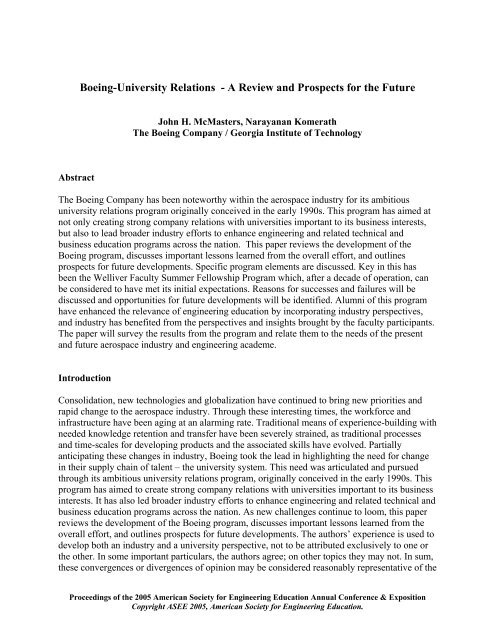
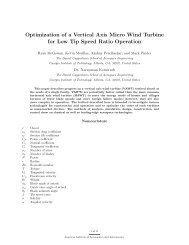
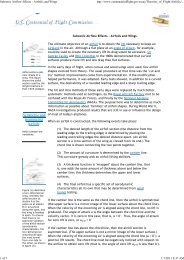

![p density of fluid, kg/m3 [Greek letter rho] V mean velocity of fluid, m ...](https://img.yumpu.com/50595898/1/184x260/p-density-of-fluid-kg-m3-greek-letter-rho-v-mean-velocity-of-fluid-m-.jpg?quality=85)
